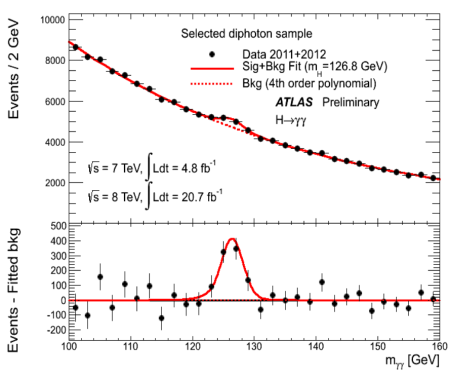At the XLVIII Moriond Conference on Electroweak Interactions and Unified Theories, on March 6, 2013, ATLAS and CMS presented updates on the Higgs candidate, often with the full data set. For ATLAS, that is 20.7 /fb (inverse femtobarns) at 8 TeV from 2012, and 4.8 /fb at 7 TeV from 2011.
I noticed in the title of the talks that the Higgs is now refered to as BEH, standing for three developers of the theory, Robert Brout and Francois Englert, and Peter Higgs. Gerard Guralnik, C. R. Hagen, and Tom Kibble are also independent developers of the theory.
Here is the ATLAS summary presented by Bruno Mansoulie (CEA-Saclay)
The ratio of the observed to expected events (or cross sections) compared to the standard model is called mu, and for the five channels in the figure is
μ = 1.43 ± 0.21,
as shown at the bottom of the figure. Comparing the deviation from the standard model of 0.43, with the error of measurement or sigma (σ) of 0.21, we say the deviation is about two sigma, which is indicative but not definitive of a problem. Since this analysis is the full set to date, one might have expected the result to approach the standard model with more data, but this is not happening.
If we separate the errors for statistics, from the number of events, and systematics, from the accuracy of the detector, the result reads
μ = 1.43 ± 0.16 (stat) ± 0.14 (syst).
The worst fit is to the Higgs to two photons, or H → γ γ. The combined fit of the five ratios to the standard model only has a likelihood of 8%. However, several ratios are near the standard model considering the large size of their errors, so the agreement with the average of 1.43 has a likelihood of 32%.
The Higgs to two photons was covered in a talk by Fabrice Hubaut of CPPM. First of all, the existence of a particle is now at a 7.4 sigma significance, which means so far out on a bell probability curve (Gaussian) that it is 7.4 times the width of the curve. Five sigma is considered certainty in physics.
The experimental production ratio of Higgs to two photons to the standard model expectation is
μ = 1.65 + 0.34 – 0.30, where the + and – are errors in the positive and negative directions.
The 0.65 excess is quoted as 2.3 sigma from the standard model, although it looks closer to just 2 sigma. The ratio broken down by statistical and systematic errors is
μ = 1.65 ± 0.24 (stat) + 0.25 – 0.18 (systematic), where the + and – are systematic errors in the positive or negative directions.
The Higgs is supposed to be a scalar or spin zero boson, and with positive parity. The negative parity scalar can now be ruled out at 99.6%, and the spin 1 assignment with positive parity can be ruled out at 99.4%.
Its nice to see the new Higgs to two photon peak below, as well as the fact that the excess is clear in three bins (ATLAS collaboration copyright CERN 2013)


